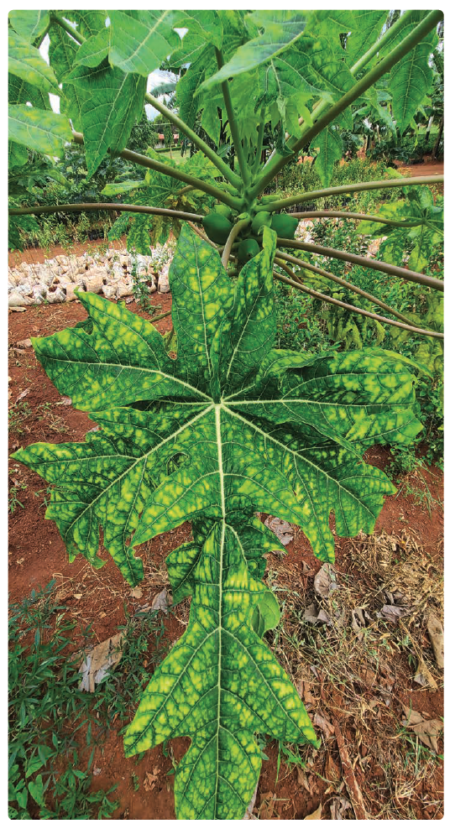By Job Kihara, Mordecai Mkiza, Dominic Mutambu, Michael Kinyua, Obadiah Mwangi, Peter Bolo, Feyera Liben, and Wuletawu Abera
Soil health is an essential foundation for providing the food requirements of a growing population. Technologies for improving soil health are available, but many are only practiced to a limited extent. Partnerships involving governments, the private sector, and research and development initiatives promise to accelerate the packaging of the available data and information; and develop and deliver tailored recommendations that support sustainable soil health management.
Soil health, the capacity of soil to function and provide ecosystem services, is important for sustained food and nutritional security in sub-Saharan Africa (SSA). Agriculture contributes about 23% of the region’s GDP and employs about 60% of its population. With Africa’s population expected to increase 2.5 times and cereal demand to triple by 2050 (Van Ittersum et al., 2016), soil health is critical. An estimated 65% of the arable land in SSA is degraded, with annual losses of soil nutrients worth approximately US$4 billion. The degradation of the soil’s physical, chemical, and biological properties is due to unsustainable land use practices. The main forms of degradation include nutrient depletion, erosion, organic matter loss, biodiversity loss, contamination, acidification, salinization, sodification, waterlogging, compaction, and crusting (Table 1; Bado and Bationo, 2018). For example, decline in soil organic carbon (SOC) has been reported from long-term (over 10 years) trials in Kenya, Nigeria, and Togo (Kihara et al., 2020).
Soil health contributes not only to increased crop productivity but also to other ecosystem services, including climate change regulation through greenhouse gas emission controls and C sequestration, water quality provisioning through controlled water and nutrient movements, supporting the functioning of soil organisms and their roles in nutrient cycling, and even cultural services through aesthetic landscapes (Kihara et al., 2020). A healthy soil also supports pest regulation and disease suppression. Soil health is also linked to human nutritional security through improved produce quality. Human nutritional deficiencies have been correlated with poor soils and micronutrients such as iron and zinc. The health and productivity of populations in SSA can be affected by soil health (Joy et al., 2015).
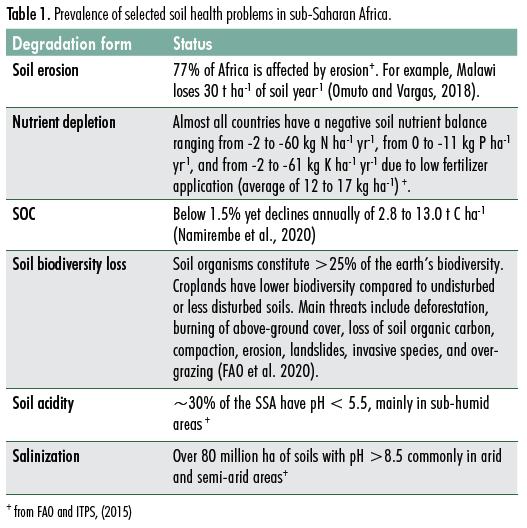
The common strategies and practices for enhancing soil health in Africa include conservation agriculture, Integrated Soil Fertility Management (ISFM), agroforestry, crop associations (strip/ intercropping, crop rotation), green manure cover crops (GMCC), and pit cultivation technologies. Recently, regenerative agriculture and agroecology approaches have gained interest. Here, the extent of use for the above soil health-promoting strategies is assessed, and some challenges and opportunities discussed.

Managing soil health in sub-Saharan Africa
Conservation agriculture
Conservation agriculture (CA), a practice integrating minimum soil disturbance, permanent soil cover, and crop rotation/associations, is important for soil health and the associated ecosystem services (Fig. 1). Scientists have demonstrated more SOC under CA relative to conventional tillage (Sommer et al., 2018; Chivenge et al., 2007), improved soil structure, enhanced soil biodiversity and biological activity (Bolo et al., 2021), soil water infiltration and retention. Despite reduced yields in the initial years of converting to CA in some cases, increased yields are expected in the long term (Kihara et al., 2020; Thierfelder et al., 2013).
Despite evidence of increased CA adoption (Fig. 2), hurdles to its adoption include inadequate equipment and machinery to mechanize operations, low supply/ availability of crop residues for mulching, and competing needs for residue use as animal feed. Yet, 50% of the farmers are willing to pay for mechanized minimum tillage (Ngoma et al., 2023). Thus, with adequate equipment and machinery there is potential for widespread adoption of CA and participatory CA technology testing can support information diffusion as farmers become agents of change.
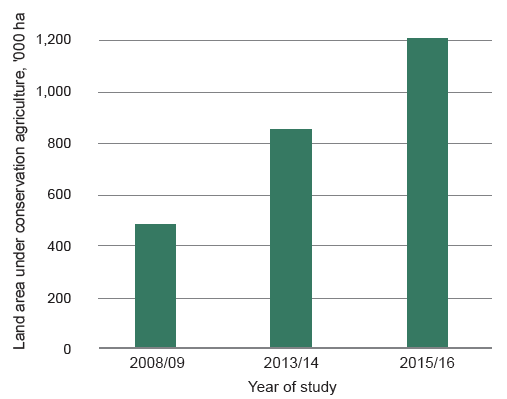
Integrated soil fertility management
ISFM consists of four critical components: (i) improved crop varieties; (ii) fertilizer; (iii) organic resources; and (iv) local adaptation, which includes soil and water conservation practices. ISFM is effective for sustainable soil health management and increases productivity in smallholder farms reaching up to 300% in some cases, depending on the level of ISFM implementation. But many farmers only have a selected set of ISFM components, even though yields (Fig. 3) and economic returns increase with the number of components (Kihara et al., 2022). Employing an increasing number of ISFM components is associated with increased labor costs, but these are often offset by the economic gains. Unlocking limitations that lead farmers to partial ISFM adoption is important.
The practice of ISFM among farmers varies within and across regions. According to Kihara et al. (2022), farmers practiced 1 to 4 ISFM components in sub-humid agroecological zones (AEZs) of Tanzania relative to 0 to 3 components in semi-arid AEZs. There is often high variability in the mix of ISFM components, even within a region, reflecting the complex socioeconomic and biophysical variability that characterizes smallholder farms (Giller et al., 2006; Hörner and Wollni, 2021). Tailored and site-specific management recommendations, and the availability of the inputs required, can support adoption. Sustained scaling out through various strategies is required, especially through national efforts.
Fertilizer use in the ISFM framework can double crop yields. Yet, application rates remain low (Chianu et al., 2012), because of high costs and low returns due to low nutrient use efficiencies under suboptimal recommendations and management conditions. New tailored fertilizer recommendations, for example, in Ethiopia, increased wheat yields (24 to 38%) and profits (Fig. 4; Liben et al., 2022). Modest rice and maize yield increases of 11% and 4%, respectively, were also observed elsewhere compared to blanket recommendations (Chivenge et al., 2022). Upscaling these efforts can result in large changes in the African agricultural landscape. Low rates of fertilizer application in SSA contribute small amounts to greenhouse gases (e.g., N2O-N emissions from cropland in SSA range from 0.4 to 3.9 kg N2O-N ha-1 year-1; Kihara et al., 2020). However, groundwater contamination and eutrophication of water bodies, linked to uncurbed runoff is widespread. Thus, upscaling of fertilizer recommendations should be accompanied with sustainable land management practices.
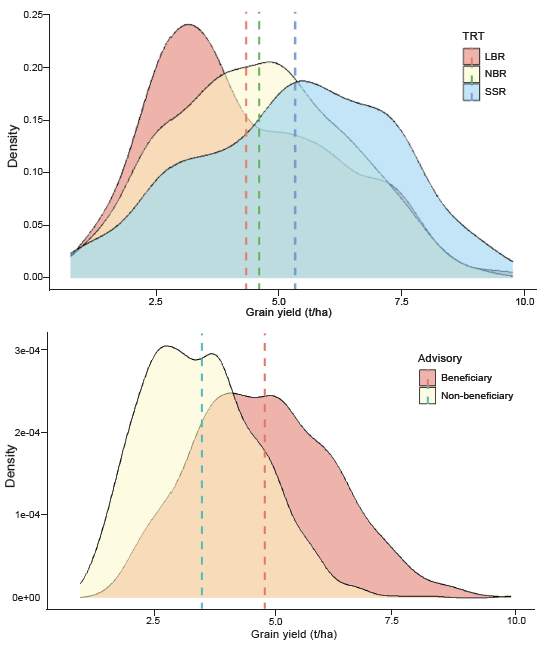
Combined application of organic resources and mineral fertilizers is associated with greater nutrient use efficiency and yields than with either organics or mineral fertilizers alone. The manure applied on croplands across Africa can cover just about 10% of croplands (FAOSTAT; Table 2). When combined with fertilizers, the area applied with manure can extend.
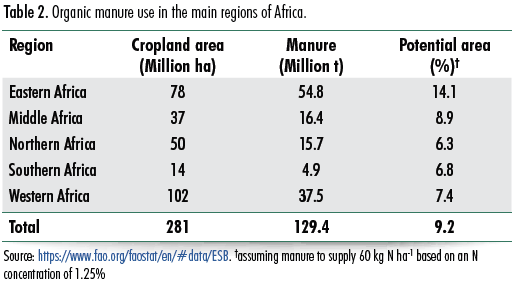
Crop associations
Intercropping is widespread in SSA and is associated with increased land equivalent ratios relative to monocrops. Cereal-legume intercrops improve soil biophysical and chemical conditions (Chikowo et al., 2020) and fix N (e.g., 53 to 84 kg N ha-1; Mugi-Ngenga et al., 2022). Unfortunately, intercropping systems are often characterized by low yields of the legume intercrops.
Strip cropping innovations increase legume yields, for instance by 101%, 52%, and 15% for groundnuts, soybean, and beans, respectively (Woomer et al., 2004). A triple crop, strip-cropping innovation, Mbili-Mbili, recently developed in Tanzania and now introduced to Malawi and Zimbabwe, improved smallholder food and nutritional security through increased and seasonally distributed harvests and increased revenues (by $150 ha-1 season-1) and their stability (Kinyua et al., 2023). Scaling uptake of these innovations is important to improve soil health and the livelihoods of smallholder farmers.
Legume cover crops provide positive changes of 1 to 133% across various soil health indicators (Fig. 6; Jian et al. 2020). Despite the benefits, adoption of cover crops in Africa is still below 50% (Autio et al. 2021), attributed to limited cultivation knowledge, access to seeds, increased labor during cultivation and incorporation, and loss of crop season when rotated with food crops.
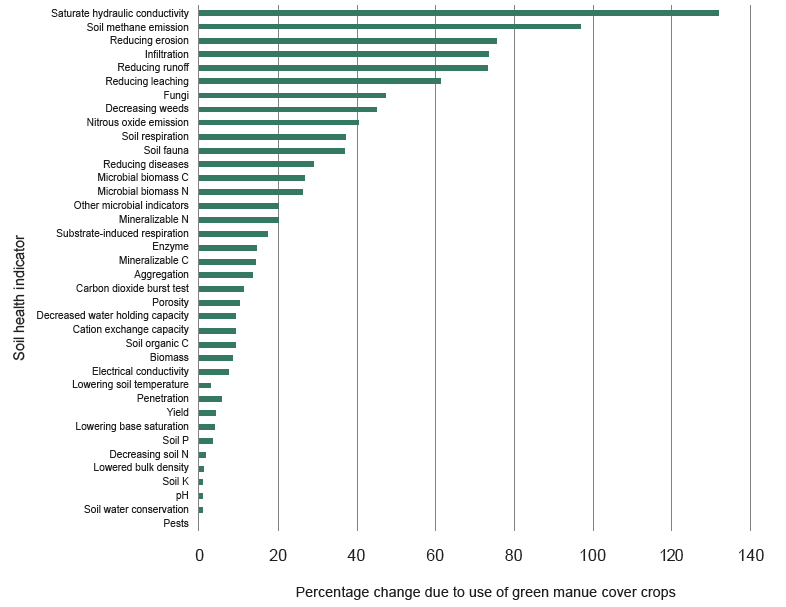
Under mixed crop-livestock systems, ley rotation of annual crops with managed perennial/ annual grass or grass–legume mixtures (ley) improve crop productivity (5-135%) as well as soil properties (e.g., pH 4%, SOC 12%, pore space 4%, percolation 12%, and infiltration 22%; Fig. 7; Wortmann et al., 2021). Alternate ley with annual crop strips of 5-20 m width and rotation cycles of 6-10 yr is recommended (Wortmann et al., 2021). Push-pull is a specific ley cropping technology that integrates N-fixing crops (e.g., Desmodium) and Napier grass strips to increase crop productivity (e.g., 100 to 200% more cereal grain yields in western Kenya; Khan et al., 2011).
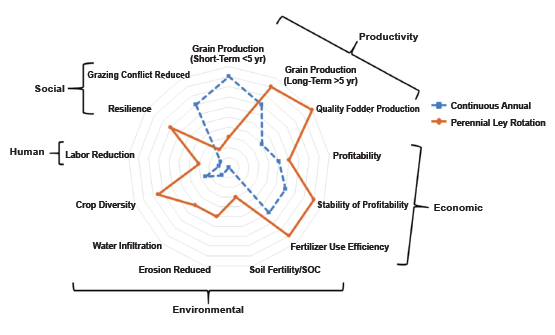
Agroecology
Agroecology encompasses all the practices presented here and others (i.e., agroforestry, regenerative agriculture) and is considered as a concept guided by specific principles. In Africa, agroecology can vary greatly across farms with 1 to 5 practices commonly implemented (Fig. 8). Approximately 40% of cropland in Africa is under agroforestry, with >45% in humid regions of West Africa, 30% in sub-humid Africa, and <10% in Sahara regions (Zomer et al., 2016; Miller, et al., 2017; Kuyah et al., 2021). In Kenya, 56% of the farmers were inadequately informed and 80% required training in regenerative agriculture (Otara et al., 2023). Inadequate knowledge and skills among farmers, and unsupportive policies are barriers to the success of regenerative agriculture. Further scaling of agroecological practices in Africa is important to restore soil health.

Integrated soil fertility and water management
ISFM and in-situ water harvesting in practices involving variable pit cultivation such as Matengo pits (Tanzania), Pfumvudza (Zimbabwe), Mambwe (Zambia), Dagomba (Ghana), Zai pits (Mali and Burkina Faso), Tassa (Niger), and Teras (Sudan) with soil organic matter input into planting pits to build soil organic C (Nyamadzawo et al., 2013), control soil erosion and have the potential to improve soil health. While in specific places the uptake of these practices is appreciable, for example, 50% of smallholder farmers use Matengo in Mbinga district of southern Tanzania (Malekela and Lusiru, 2022), and 52% use Zai Pits in northern Ghana (Danquah et al., 2019), adoption in other places is low and constrained by limited labor and insufficient extension services.
Conclusions
Many soil health-promoting practices are available in SSA, but their adoption remains limited across SSA. Evaluation of the relevance of technologies for specific sites and targeted dissemination is necessary to accelerate adoption and impact. Participatory co-design and implementation processes and farmer training can support farmers to adapt innovations to meet the productivity and soil health targets at the farm and community levels.
Advances in data science and digital technologies offer opportunities for the consolidation and analysis of agronomic data to promote tailored guidelines that are more relevant to the needs and demands of farmers. Research and development institutions, such as the CGIAR through its Excellence in Agronomy Program, are driving research efforts to organize data and support analytics and tool development to generate site and context-specific advisory services. Building broader alliances with public and private sector partners will be necessary to deliver effective advisory services and create an enabling environment for the adoption of innovation for sustainable soil health management.
Dr. Kihara (e-mail: j.kihara@cgiar.org), and Messrs. Mkiza, Bolo, Kinyua, and Mwangi are Agronomists with the Alliance of Bioversity International and CIAT, Nairobi, Kenya. Mr. Mutambu is Research Consultant with CIAT, Kenya. Dr. Liben is Systems Agronomist with Adama, Ethiopia. Dr. Abera is CIAT Senior Scientist, Ethiopia.
Acknowledgment
This work is part of Excellence in Agronomy Initiative (EiA) of the CGIAR.
Cite this article
Kihara, J., Mkiza, M., Mutambu, D., Kinyua, M., Mwangi, O., Bolo, P., Liben, F., Abera, W. 2023. Soil Health in Sub-Saharan Africa: Status and solutions, Growing Africa 2(1), 16-22. https://doi.org/10.55693/ga21.EAQG1636
REFERENCES
Autio, A., et al. 2021. Constraints for adopting climate-smart agricultural practices among smallholder farmers in Southeast Kenya. Agric. Sys. 194, 103284.
Bado, V.B., Bationo, A. 2018. Integrated management of soil fertility and land resources in Sub-Saharan Africa: involving local communities. Adv. in Agron. 150, 1-33.
Bolo, P., et al. 2021. Application of residue, inorganic fertilizer and lime affect phosphorus solubilizing microorganisms and microbial biomass under different tillage and cropping systems in a Ferralsol. Geoderma 390, 114962.
Chianu, J.N., Mairura, F. 2012. Mineral fertilizers in the farming systems of sub-Saharan Africa. A review. Agron. for Sust. Dev. 32, 545-566.
Chikowo, R., et al. 2020. Ecosystem services in doubled-up legume systems. In The Role of Ecosystem Services in Sustainable Food Systems (pp. 171-180). Academic Press.
Chivenge, P.P., et al. 2007. Long-term impact of reduced tillage and residue management on soil carbon stabilization: Implications for conservation agriculture on contrasting soils. Soil & Tillage Res. 94(2), 328-337. Chivenge, P., et al. 2022. Progress in research on site-specific nutrient management for smallholder farmers in sub-Saharan Africa. Field Crops Res. 281, 108503.
Danquah, F.O., Twumasi, M.A., Asare, I. 2019. Factors influencing Zai pit technology adaptation: The case of smallholder farmers in the upper east region of Ghana. Agric. Res. & Tech. 21, 13-24.
FAO & ITPS. 2015. Status of the World’s Soil Resources (SWSR) – Main Report. Food and Agriculture Organization of the United Nations and Intergovernmental Technical Panel on Soils, Rome, Italy.
FAO, ITPS, GSBI, CBD and EC. 2020. State of knowledge of soil biodiversity – Status, challenges and potentialities, Report 2020. Rome, FAO.
Giller, K.E., et al. 2006. Resource use dynamics and interactions in the tropics: Scaling up in space and time. Agric. Sys. 88(1), 8-27.
Hörner, D., Wollni, M. 2021. Integrated soil fertility management and household welfare in Ethiopia. Food Policy 100, 102022.
Jian, J., et al. 2020. A calculator to quantify cover crop effects on soil health and productivity. Soil & Tillage Res. 199, 104575.
Joy, E.J., et al. 2015. Zinc-enriched fertilisers as a potential public health intervention in Africa. Plant & Soil 389, 1-24.
Kassam, A., Friedrich, T., Derpsch, R. 2019. Global spread of conservation agriculture. Int. J. Environ. Studies 76(1), 29-51.
Khan, Z., et al. 2011. Push—pull technology: A conservation agriculture approach for integrated management of insect pests, weeds and soil health in Africa: UK government’s Foresight Food and Farming Futures project. Int. J. Agric. Sust. 9(1), 162-170.
Kihara, J., et al. 2020. Soil health and ecosystem services: Lessons from sub-Sahara Africa (SSA). Geoderma 370, 114342.
Kihara, J., et al. 2022. Contributions of integrated soil fertility management (ISFM) to various sustainable intensification impact domains in Tanzania. Agric. Sys. 203, 103496.
Kinyua, M.W., et al. 2023. Agronomic and economic performance of legume-legume and cereal-legume intercropping systems in Northern Tanzania. Agric. Sys. 205, 103589.
Kuyah, S., et al. 2021. Innovative agronomic practices for sustainable intensification in sub-Saharan Africa. A review. Agron. for Sust. Dev. 41, 1-21.
Liben, F., et al. 2022. Co-developing and co-validating location-specific fertilizer and agroclimate advisory service for Wheat in Ethiopia: The Digital Green Use Case.
Malekela, A.A., Lusiru, S.N. 2022. Climate change adaptation strategies through traditional farming practices. The case of Matengo pits in Mbinga District, Tanzania. Int. J. Res. Publication & Reviews, 3(5), 3023-3033.
Miller, D.C., Muñoz-Mora, J.C., Christiaensen, L. 2017. Prevalence, economic contribution, and determinants of trees on farms across Sub-Saharan Africa. Forest Policy & Economics 84, 47-61.
Montt, G., Luu, T. 2020. Does conservation agriculture change labour requirements? Evidence of sustainable intensification in Sub-Saharan Africa. J. Agric. Econ. 71(2), 556-580.
Mugi-Ngenga, E., et al. 2022. The role of nitrogen fixation and crop N dynamics on performance and legacy effects of maize-grain legumes intercrops on smallholder farms in Tanzania. Eur. J. Agron. 141, 126617.
Namirembe, S., et al. 2020. Soil organic carbon in agricultural systems of six countries in East Africa–a literature review of status and carbon sequestration potential. South African J. Plant & Soil, 37(1), 35-49.
Ngoma, H., et al. 2023. Smallholder farmers’ willingness to pay for two-wheel tractor-based mechanisation services in Zambia and Zimbabwe. J. Int. Dev.
Nyamadzawo, G., et al. 2013. Opportunities for optimization of in-field water harvesting to cope with changing climate in semi-arid smallholder farming areas of Zimbabwe. SpringerPlus 2, 1-9.
Omuto, C.T., Vargas, R.R. 2018. Soil nutrient loss assessment in Malawi. Technical Report. FAO, UNEP and UNDP. 64 pp.
Otara, E.N., et al. 2023. Socioeconomic Factors Influencing Uptake of Regenerative Agriculture Technologies in the Dry-lands of Embu County, Kenya. J. Agric. Ext. 27(1), 1-12.
Van Ittersum, M. K., et al. 2016. Can sub-Saharan Africa feed itself? Proc. Nat. Acad. Sci. 113(52), 14964–14969.
Viability Project Team. 2023. Agroecological practices are widely used by African farmers. Working Paper 2. Bogor, Indonesia and Nairobi, Kenya: CIFOR-ICRAF: The Transformative Partnership Platform on Agroecology.
Woomer, P.L., et al. 2004. Innovative maize-legume intercropping results in above-and below-ground competitive advantages for understorey legumes. West African J. Applied Ecology 6(1).
Wortmann, C.S., et al. 2021. Perennial grass ley rotations with annual crops in tropical Africa: A review. Agron. J. 113(6), 4510-4526.
Zomer, R.J., et al. 2016. Global Tree Cover and Biomass Carbon on Agricultural Land: The contribution of agroforestry to global and national carbon budgets. Scientific Reports 6(1), 29987



